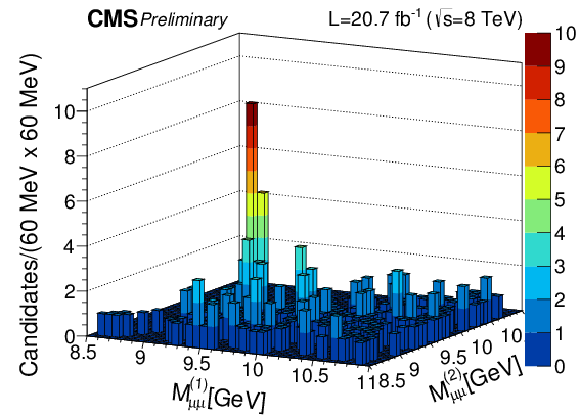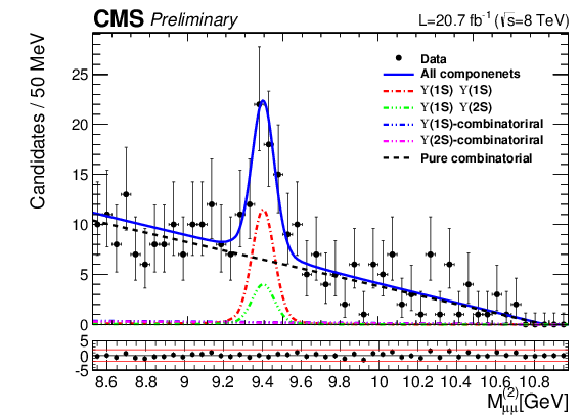

Compact Muon Solenoid
LHC, CERN
| CMS-PAS-BPH-14-008 | ||
| Observation of $\Upsilon(1S)$ pair production at CMS | ||
| CMS Collaboration | ||
| May 2016 | ||
| Abstract: The simultaneous production of two $\Upsilon(1S)$ mesons in proton-proton collisions is observed by CMS at $\sqrt s = $ 8 TeV at LHC in a data sample corresponding to an integrated luminosity of 20.7 fb$^{-1}$. The statistical significance is well in excess of 5 standard deviations. Both $\Upsilon$ candidates are fully reconstructed via their decays into $\mu^{+}\mu^{-}$. The acceptance region is defined by the individual $\Upsilon$ rapidity, $y(\Upsilon)$, and transverse momentum, $p_{\mathrm{T}}(\Upsilon)$: $|y(\Upsilon)| <$ 2.0 and $p_{\mathrm{T}}(\Upsilon)<$ 50 GeV. The total cross section for the production of $\Upsilon(1S)$ pairs assuming that both $\Upsilon(1S)$ mesons decay isotropically, is measured to be 68.8 $\pm$ 12.7 (stat) $\pm$ 7.4 (syst) $\pm$ 2.8 (BR) pb, where the third uncertainty results from the uncertainty in the $\Upsilon(1S) \rightarrow \mu^{+}\mu^{-}$ branching fraction. Different assumptions about the $\Upsilon(1S)$ polarization imply modifications to the cross section ranging from -38% to 36%. | ||
|
Links:
CDS record (PDF) ;
inSPIRE record ;
CADI line (restricted) ;
These preliminary results are superseded in this paper, JHEP 05 (2017) 013. The superseded preliminary plots can be found here. |
||
| Figures | |

png pdf |
Figure 1:
Lego plot of $M^{(1)}_{\mu \mu }$ vs $M^{(2)}_{\mu \mu }$. |

png pdf |
Figure 2-a:
Projections of the 2D fit. (a) invariant mass of higher mass muon pairs, $M^{(1)}_{\mu \mu }$. (b) invariant mass of lower mass muon pairs, $M^{(2)}_{\mu \mu }$. The lower pads show the difference between the total fit curve and data, with red lines corresponding to a difference of $\pm $2 standard deviations. |

png pdf |
Figure 2-b:
Projections of the 2D fit. (a) invariant mass of higher mass muon pairs, $M^{(1)}_{\mu \mu }$. (b) invariant mass of lower mass muon pairs, $M^{(2)}_{\mu \mu }$. The lower pads show the difference between the total fit curve and data, with red lines corresponding to a difference of $\pm $2 standard deviations. |
| Tables | |

png pdf |
Table 1:
Summary of relative systematic uncertainties in the $\Upsilon $ pair production cross section. |

png pdf |
Table 2:
Relative change of acceptance corrected yield for different polarization assumptions. |
| Summary |
| The $\Upsilon(1S)$ meson pair production where both $\Upsilon(1S)$ mesons originate from the common vertex is observed with the CMS detector in proton-proton collisions at $\sqrt s=$ 8 TeV at the LHC from a sample corresponding to an integrated luminosity of 20.7 fb$^{-1}$. A signal yield of 38 $\pm$ 7 $\Upsilon(1S)\Upsilon(1S)$ events is measured with the local significance, including systematics, that exceeds five standard deviations. Using the measured muon kinematics in the data, an event-based acceptance and efficiency correction method is applied, minimizing the model dependence of the cross section measurement. The total cross section of $\Upsilon(1S)$ pair production measured within the single $\Upsilon$ acceptance, $|y(\Upsilon)|<$ 2.0 and $p_{\mathrm{T}}(\Upsilon)<$ 50 GeV, is found to be $\sigma_{\mathrm{T}} = $ 68.8 $\pm$ 12.7 (stat) $\pm$ 7.4 (syst) $\pm$ 2.8 (BR) pb, where the $\Upsilon(1S)$ decay into muons is assumed to be isotropic. Different assumptions about the $\Upsilon(1S)$ polarization imply modifications to the cross section ranging from -38% to 36%. |
| References | ||||
| 1 | A. Berezhnoy, A. Likhoded, A. Luchinsky, and A. Novoselov | Double J/psi-meson Production at LHC and 4c-tetraquark state | Phys.Rev. D84 (2011) 094023 | 1101.5881 |
| 2 | A. V. Berezhnoy, A. V. Luchinsky, and A. A. Novoselov | Tetraquarks Composed of 4 Heavy Quarks | PRD86 (2012) 034004 | 1111.1867 |
| 3 | NA3 Collaboration Collaboration | Evidence for $ \psi \psi $ Production in $ \pi^- $ Interactions at 150-GeV/$ c $ and 280-GeV/$ c $ | Phys.Lett. B114 (1982) 457 | |
| 4 | LHCb Collaboration Collaboration | Observation of $ J/\psi $ pair production in $ pp $ collisions at $ \sqrt{s} = $ 7 TeV | Phys.Lett. B707 (2012) 52--59 | 1109.0963 |
| 5 | CMS Collaboration | Measurement of prompt $ J/\psi $ pair production in pp collisions at $ \sqrt{s} $ = 7 TeV | JHEP 09 (2014) 094 | CMS-BPH-11-021 1406.0484 |
| 6 | D0 Collaboration | Evidence for simultaneous production of $ J/\psi $ and $ \Upsilon $ mesons | PRL 116 (2016), no. 8, 082002 | 1511.02428 |
| 7 | B. L. Ioffe, V. A. Khoze, and L. N. Lipatov | Hard processes. vol. 1: phenomenology, quark parton model | 1985 | |
| 8 | P. Bartalini et al. | Multi-Parton Interactions at the LHC | 2011 | 1111.0469 |
| 9 | Quarkonium Working Group Collaboration | Heavy quarkonium physics | hep-ph/0412158 | |
| 10 | S. D. Ellis, M. B. Einhorn, and C. Quigg | Comment on Hadronic Production of Psions | PRL 36 (1976) 1263 | |
| 11 | C. E. Carlson and R. Suaya | Hadronic Production of psi/J Mesons | PRD14 (1976) 3115 | |
| 12 | J. H. Kuhn | Hadronic Production of $ P $ Wave Charmonium States | PLB89 (1980) 385 | |
| 13 | F. Halzen and S. Matsuda | Hadroproduction of Quark Flavors | PRD17 (1978) 1344 | |
| 14 | E. Braaten and S. Fleming | Color octet fragmentation and the psi-prime surplus at the Tevatron | PRL 74 (1995) 3327--3330 | hep-ph/9411365 |
| 15 | M. Gluck, J. F. Owens, and E. Reya | Gluon Contribution to Hadronic J/psi Production | PRD17 (1978) 2324 | |
| 16 | H. Fritzsch | Theoretical Aspects of e+ e--Annihilation Into Hadrons | PRD10 (1974) 1624 | |
| 17 | F. Yuan and K.-T. Chao | High $ p_{T} \psi \psi $ production as strong signals for double parton scattering at the Tevatron | J.Phys. G24 (1998) 1105--1112 | hep-ph/9706293 |
| 18 | A. Novoselov | Double parton scattering as a source of quarkonia pairs in LHCb | 1106.2184 | |
| 19 | S. Baranov, A. Snigirev, and N. Zotov | Double heavy meson production through double parton scattering in hadronic collisions | Phys.Lett. B705 (2011) 116--119 | 1105.6276 |
| 20 | P. Ko, C. Yu, and J. Lee | Inclusive double-quarkonium production at the Large Hadron Collider | JHEP 1101 (2011) 070 | 1007.3095 |
| 21 | ATLAS Collaboration | Measurement of Upsilon production in 7 TeV pp collisions at ATLAS | PRD87 (2013), no. 5, 052004 | 1211.7255 |
| 22 | CMS Collaboration Collaboration | Measurement of the $ \Upsilon(1S), \Upsilon(2S) $, and $ \Upsilon(3S) $ cross sections in pp collisions at $ \sqrt{s} $ = 7 TeV | Phys.Lett. B727 (2013) 101--125 | 1303.5900 |
| 23 | LHCb Collaboration | Measurement of Upsilon production in pp collisions at $ \sqrt{s} $ = 7 TeV | EPJC72 (2012) 2025 | 1202.6579 |
| 24 | CMS Collaboration | Description and performance of track and primary-vertex reconstruction with the CMS tracker | JINST 9 (2014), no. 10, P10009 | CMS-TRK-11-001 1405.6569 |
| 25 | CMS Collaboration | Performance of CMS muon reconstruction in pp collision events at $ \sqrt{s}=7 $ TeV | JINST 7 (2012) P10002 | CMS-MUO-10-004 1206.4071 |
| 26 | CMS Collaboration | The CMS experiment at the CERN LHC | JINST 3 (2008) S08004 | CMS-00-001 |
| 27 | H. Jung et al. | The CCFM Monte Carlo generator CASCADE version 2.2.03 | Eur.Phys.J. C70 (2010) 1237--1249 | 1008.0152 |
| 28 | T. Sjostrand, S. Mrenna, and P. Z. Skands | A Brief Introduction to PYTHIA 8.1 | Comput.Phys.Commun. 178 (2008) 852--867 | 0710.3820 |
| 29 | GEANT4 Collaboration | GEANT4: A Simulation toolkit | NIMA506 (2003) 250--303 | |
| 30 | R. Fruhwirth | Application of Kalman filtering to track and vertex fitting | NIMA262 (1987) 444--450 | |
| 31 | M. Oreglia | {A Study of the Reactions $\psi? \to \gamma\gamma \psi$} | PhD thesis, Standford University, 1980SLAC Report SLAC-R-236 | |
| 32 | W. Verkerke and D. P. Kirkby | The RooFit toolkit for data modeling | eConf C0303241 (2003) MOLT007, [,186(2003)] | physics/0306116 |
| 33 | S. S. Wilks | The Large-Sample Distribution of the Likelihood Ratio for Testing Composite Hypotheses | The Annals of Mathematical Statistics 9 (1938), no. 1, 60--62 | |
| 34 | L. Moneta et al. | The RooStats Project | PoS ACAT2010 (2010) 057 | 1009.1003 |
| 35 | CMS Collaboration Collaboration | CMS Luminosity Based on Pixel Cluster Counting - Summer 2013 Update | Technical Report CMS-PAS-LUM-13-001, CERN, Geneva | |
| 36 | Particle Data Group Collaboration | Review of Particle Physics (RPP) | PRD86 (2012) 010001 | |
| 37 | CMS Collaboration | Measurement of the $ Y(1S), Y(2S) $ and $ Y(3S) $ polarizations in $ pp $ collisions at $ \sqrt{s}=7 $ TeV | PRL 110 (2013), no. 8, 081802 | CMS-BPH-11-023 1209.2922 |

|
Compact Muon Solenoid LHC, CERN |

|

|

|

|

|

|